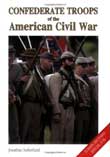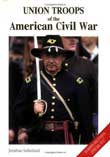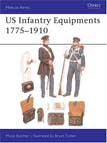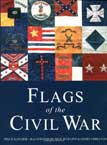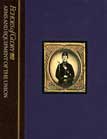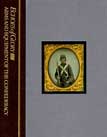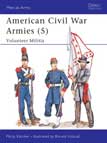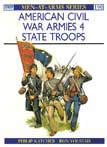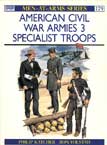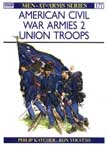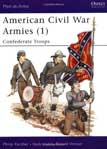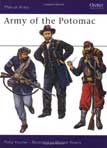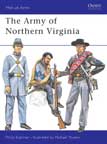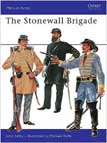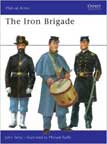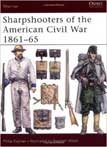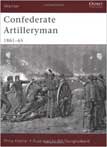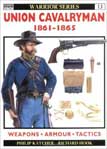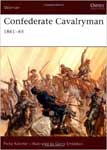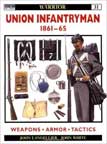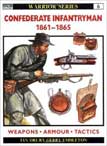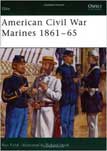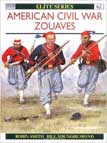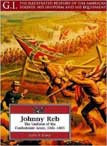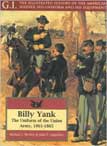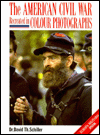

A catastrophic and ruinous civil war raged across the fledgling United States between 1861 and 1865. The conflict pitted brother against brother, father against son and friend against friend. This book minutely examines the uniforms and equipment of the Confederacy, a patchwork of states, comprising of the southern aristocracy, farm hands and state militiamen. Often hopelessly outnumbered, they held back the inevitable tide of blue of the Union for four years. This book not only examines the uniforms, but also the equipment, weapons, battle flags, tactics and organization of the Confederate armies. Indispensable for military historians, collectors, wargamers and re-enactors.
A catastrophic and ruinous civil war raged across the fledgling United States between 1861 and 1865. The conflict pitted brother against brother, father against son and friend against friend. This book minutely examines the uniforms and equipment of the Union troops of, primarily, the northern United States. 'Billy Yanks' were recruited in vast numbers. First, second or third generation European immigrants flooded the ranks of the Union armies. Although they often outnumbered the Confederates, the Union troops were poorly led and trained, yet by force of arms they crushed the rebellion, culminating in Robert E Lee's surrender at Appomattox in 1865.
The development of US Army infantry equipment has been a story of trial and error, of adopting new designs to meet new problems. It was not until 1910 that a whole system of equipment, including everything from the waist belts to the canteens to the cartridge-carriers to the haversack, was officially adopted. Prior to that, each piece of equipment was designed to meet a specific need, without any consideration of anything else the soldier had to carry. Packed with photographs and illustrations, this book explores the history of US Infantry equipments from 1775 to 1910, covering everything from blankets to bayonets.
[This book combines Men-at-Arms 252: "Flags of the American Civil War 1: Confederate," Men-at-Arms 258: "Flags of the American Civil War 2: Union" and Men-at-Arms 265: "Flags of the American Civil War 3: Specialist Troops."]
The flags of the Civil War were no mere unit designations—they represented the very hearts of their regiments. The formal ceremony in which a regiment received its colors constituted an initiation into the world of the soldier, and the flag became the symbol which drew the regiment's members together. In camp, regimental colors flew over unit headquarters as a guidepost to members and outsiders alike; in action, it flew in the center of the line, drawing enemy fire upon its carriers. Few things were more disgraceful than losing one's colors in battle, and extreme sacrifices were often made to save them.
Since the Civil War ended, the uniforms of the Union Soldiers have been portrayed as basically blue with the gold buttons going down the center. While this is marginally accurate, the uniforms of the Union Soldiers that fought in the Civil War were actually unique and had various patterns. In this excellent book, the uniforms are shown in color, and they are quite different, yet the same in general appearance. It is informative, interesting and enjoyable to view the wide variety of Officer and Enlisted Uniforms that were worn during the Civil War.
Also presented in this fine book are the various flags that were flown by regiments in battle. Flags made by Tiffany's to Women from throughout the Union, these flags were in fierce battle and were held by brave men who in quite a few instances gave the ultimate sacrifice by waving their regimental flags.
Cannons, Swords, Pistols, Rifles and other arms are shown as well as Cannons, Canteens, and various other equipment that was used by Union Soldiers are displayed.
This is the companion book to the Arms and Equipment of the Confederacy and both books are a MUST have in the serious Civil War Historian, and aficionado's library.
This book provides invaluable material to anyone who has a serious interest in the Civil War. This book was put together by the editors of Time/Life and they did their research accurately. This book describes the arms (weapons) and the equipment (from canteens to buttons) that the average Confederate enlisted soldier to the Confederate General used during the Civil War.
Each section of the book is divided into weapons (Pistols, Rifles, etc) and tells not only the type (with great photographs that are in color) but who issued them as well. From Rifles, Guns, Knives, Swords (Officer and Enlisted), to regular camp knives, they are in this book if they were issued by the Confederate Government. Even those that were homemade are listed in here as well.
The most interesting parts in my opinion are the Uniforms that the Confederate Soldier wore and the flags that were flown by individual regiments. The Confederate Soldier wore a uniform that was diverse as to the regiment each one served in. From home-spun uniforms to those acquired overseas and in stylish clothing stores, those that the editors could find and be able to use are in here (a lot of Uniforms, Flags, etc were supplied for the book by the Museum Of The Confederacy). Some of the hats that are in this book, show the holes where bullets either killed the wearer of the hat, or made it a VERY close call. Uniforms great and small are in this as well.
There is also a narrative throughout the book that is easy to follow and VERY interesting. There is a background story to some of the uniforms that tell of the wearer of them, if they died in battle, or lived to a prosperous old age.
The division/regimental flags are also in here and give the story to how they were made, if they were captured, or if they survived the war.
Uniformed volunteer units were raised by individuals, usually from an area's social élite who had enough spare money and time to spend on such enthusiasms. They voted on their unit designation, their officers and non-commissioned officers, their unit rules, and their uniform. Many future leaders learned their skills in these ranks, and volunteer militia units formed the core of many fighting units on both sides of the Mason-Dixon line. With the help of numerous photographs and illustrations, including eight full page colour plates by Ron Volstad, Philip Katcher does a fine job of detailing the uniforms of the volunteer militia of the American Civil War (1861-1865).
"The War between the States" is the term used for the American Civil War (1861-1865) throughout much of the South even today. Many on both sides – not just the South – felt that they were serving their states as much, if not more, than their central governments. Many of the states agreed; the state governments raising their own units, commissioning their officers, and supplying their men. Indeed, many of the units that fought the Civil War were supplied in large part by their own states rather than by the central government's quartermasters. Philip Katcher's fascinating text explores the uniforms of 32 states; from Alabama to Wisconsin.
At the time of the American Civil War (1861-1865), with two million men under arms, a US Army that in pre-war days had depended upon a minute number of technical troops now required virtually an army of specialists alone. Special sharpshooters were recruited for skirmishing duty; men whose wounds would have led to their discharge in the past now found themselves guarding important posts in the Veteran Reserve Corps; and large numbers of civilians found themselves in uniform as members of the Telegraph or Hospital Corps. Philip Katcher examines the organization and uniforms of the specialist troops who served in the armies of both sides.
"Look! There is Jackson standing like a stone wall. Rally behind the Virginians!" With these words General Bee ensured the reputation of Thomas Jonathan Jackson and his troops who were fighting alongside him at the battle of the First Bull Run. This reputation was enhanced in Jackson's Shenandoah Valley campaign and other operations where the Stonewall Brigade's actions gained the praise of their Confederate compatriots and the respect of their enemies. This book examines the uniforms, equipment, history and organization of the Brigade and its combat experience during the American Civil War. Detailed maps and contemporary illustrations accompany this account of their major engagements.
The Union infantrymen were the 1,700 regiments of foot soldiers who became the mainstay of "Mr Lincoln's Army." These long-suffering, hard-fighting Yankees from farmsteads, hamlets, and urban centers, saved the Union. Their hopes and fears, joy and sorrow, cowardice and bravery were recorded in diaries, letters, memoirs and legions of histories. Drawing on these narratives, contemporary images and photographs and meticulous archival research, this title provides a vivid account of how the common Union infantryman was recruited and trained, and how he lived and fought. The soldier's struggle was not insignificant--it was to preserve a nation torn asunder, where brother fought against brother.
The American Civil War (1861-1865) was predominantly an infantryman's war. Artillery had improved substantially since 1815 and guns could inflict murderous losses if they had a clear field of fire. But most Civil War battlefields were characterised by sprawling forests and broken ground. Cavalry were important for reconnaissance, raiding and rearguard actions but there was little scope for sabre charges in the grand old manner when infantrymen armed with muzzle-loading rifles could face such tactics with confidence. Ultimately, the Confederacy's survival as a nation would largely depend on the fighting ability of its 642 infantry regiments.
The part played in the Civil War (1861-1865) by the small Marine Corps of the United and Confederate States is overshadowed by the confrontations of the great armies. Nevertheless, the coastal and riverine campaigns were of real importance, given the strategic significance of the Federal blockade of southern ports, and of the struggle for the Mississippi River. Marines wearing blue and grey fought in many dramatic actions afloat and ashore – ship-to-ship engagements, cutting-out expeditions, and coastal landings. This book offers a comprehensive summary of all such battles, illustrated with rare early photographs, and meticulously researched color plates detailing the often obscure minutiae of Marine uniforms and equipment.
Micheal J. McAfee, the first author, has been a curator at the West Point Military Academy Museum for many years. He is a Fellow of the Company of Military Historians, has been at times a governor of the same, and is internationally known as an expert on the uniforms styled Zouaves, worn by U.S. forces in the Civil War, and based on those worn by French forces raised in North Africa, which in turn were influenced by the natives of the area and cut in the manner of their clothing. He is well qualified to cover this subject.
The second author, J. Phillip Langellier, has produced a slew of photo studies with incisive text on the life and times of the U.S. soldier, and his Spanish and Mexican californio predecessors also. His specialty is in gathering together contemporary source material for the illustrations. This method has the great virtue of showing what was what and when. But if no photos are available, then something may be omitted. All of these books are vertical studies covering a period of years. Though sometimes the illustrations serve to identify individual items of equipment, these works are not intended for that purpose. They are not catalogs intended for materiel collectors. They are of such a length and of such a level of detail that they will serve the purposes of the general reader with a curiousity about what grandaddy did in WW II or great great great grandaddy in the Civil War and what he looked like and how he lived. This is not to say that the specialist cannot find useful nuggets herein. He can.
Thousands of American Civil War "re-enactment" enthusiasts were used as models in this photo-essay of the American Civil War. Whole regiments of the infantry, squadrons of mounted cavalry, and batteries of working cannon camp and manoeuvre over the actual battlefields of the 1860s.
Battle at Basing: Danish invasion army beats Ethelred of Wessex
King Robert II Stuart of Scotland crowned
Jews are expelled from Colmar Germany
Turks conquer Cairo
England and France declare war on Emperor Charles V
English Queen Elizabeth I grants Thomas Tallis and William Byrd music press monopoly
Parts of Switzerland adopt Gregorian Calendar
Pope Sixtus V decrees "Immense aeterni" (Reformed curia)
Postal service between New York and Boston inaugurated
Lord Halifax becomes Speaker of English House of Lords
Prince Willem III calls English parliament together
Iroquois tribes renew allegiance to British against French
Battle at Wandewash India: British troops beat French
Spain cedes Falkland Islands to Britain
Marshal Oscar von Lubomirski expels Jews from Warsaw Poland
Coup of Midderigh
Americans capture Frenchtown, Canada
1st Knights Templar grand encampment in US held, New York City
Lord Byron completes "Parisina" and"Siege of Corinth"
English freighter Diana sinks off Malaysia
Charles Darwin takes his Bachelors of Art exam
Earthquake in southern Syria kills thousands
Alta California becomes a daily paper, 1st such in California
National Association of Baseball Players founded, New York
Confederate government raises premium for volunteers from $10 to $20
Britains SS Northfleet sinks at Dungeness England, 300 die
James Shields (D) elected US senator from Missouri after previously serving as US senator from Illinois and Minnesota
Zulus attack British Army camp in Isandhlwana South Africa
England complete 1st innings victory in Tests vs. Aust MCG
Jose Marti forms La Liga (Union of Cuban exiles) in New York City
National Association of Manufacturers organized in Cincinnati
After 63 years England stops sale of Queen Victoria postage stamps series and begins King Edward VII series
Bloody Sunday: Russian demonstrators fired on by tsarist troops
Opera "Germania, " premieres in New York City
Ukraine proclaimed a free Republic (German puppet)
Baldwin government resigns in England
Dutch Blast Furnace and Steel Factory opens
KGO-AM in San Francisco CA begins radio transmissions
Albania Republic proclaimed under President Achmed Zogu
Belgian Chief of Staff General Maglinse quits
French government of Steeg falls
VARA begins experimental TV broadcast in Diamantbeurs Amsterdam
British Anglicans and Old-Catholic church merge
French Laval government falls
Uranium atom 1st split, Columbia University
1st radio broadcast of "Road to Happiness" on CBS
1st mass killing of Jews in Romania
British / Australian troops capture Tobruk from Italians
Japanese air raid on Rabaul, New Britain
Sietze de Groot wins 8th Dutch 11 city skate (8:44:06)
66.3 cm precipitation at Hoegees Camp, California (state record)
Joint Chiefs of Staff determine invasion in Sicily for July 10th
During World War II, Allied forces begin landing at Anzio Italy
Burma highway reopens
Heavy US air raid on Okinawa
US President sets up CIA, Central Intelligence Agency
1st commercial TV station west of Mississippi opens, Hollywood, California
KTLA TV channel 5 in Los Angeles, CA (IND) begins broadcasting
"All for Love" opens at Mark Hellinger Theater NYC for 121 performances
Chinatown telephone exchange closed
Polly Riley wins LPGA Tampa Golf Open
Bollingen Prize for poetry awarded to Johncrowe Ransom
Fidel Castro ejected from a Winter League game after beaning batter
Norwegian government of Einar Gerhardsen forms
30 die in a train crash in Los Angeles
Betsy Rawls wins LPGA Tampa Golf Open
Canadian Football Council forms
Israeli forces withdraw from Sinai Peninsula
Mad Bomber (George P Metesky) accused of 30 explosions, arrested
KRSD (now KEVN) TV channel 7 in Rapid City, SD (ABC) 1st broadcast
10th NBA All-Star Game: East beats West 125-115 at Philadelphia
Coal mine of Johnburg caves-in, 417 die
French President De Gaulle escape attempt by general Massu
Paul Pender beats Sugar Ray Robinson for middleweight boxing title
Ruth Jessen wins LPGA Naples Professional Golf Tournament
Kenneth Kaunda becomes Premier of North-Rhodesia (Zambia)
US launches TIROS 9 weather satellite
NFL Pro Bowl: East beats West 20-10
Apollo 5 launched to Moon; unmanned lunar module tests made
NBA announces it will expand to Milwaukee and Phoenix
"Celebration" opens at Ambassador Theater NYC for 110 performances
Billy Preston becomes 5th Beatle
Orbiting Solar Observatory 5 launched into earth orbit
Roy Campanella and Stan Musial elected to baseball Hall of Fame
Test debut of Barry Richards, South Africa vs. Australia, Cape Town
John andYoko record "Power to the People"
"Emergency" with Robert Fuller premieres on NBC TV
22nd NBA All-Star Game: West beats East 112-110 at LA
George Foreman TKOs Joe Frazier in 2 for heavyweight boxing title
Roe vs. Wade: US Supreme Court legalizes some abortions
US, North and South Vietnam and Vietcong sign boundary accord
Landsat 2, an Earth Resources Technology Satellite, launched
Bank robbery in Beirut nets $20-50 million (record)
Dissidents Andrei Sacharov and Jelena Bonner banished to Gorki
PGA begins a senior golf tour
West Indies beat England 2-0 to win 1st World Series Cup
40th Islander shut-out opponent-3-0 vs. Red Wings-Billy Smith 15th
O A "Bum" Phillips becomes head coach of New Orleans Saints
75% of North America is covered by snow
Houston is 1st NBA team to be held scoreless in an overtime Portland Trail Blazers out score them 17-0 and win 113-96
Hilbert van de Thumb becomes European all-round skates
Super Bowl XVIII: LA Raiders beat Washington Redskins, 38-9 in Tampa Super Bowl MVP: Marcus Allen, LA Raiders, RB
Kelly Hu, 16, of Hawaii, crowned 3rd Miss Teen USA
Ghorbanifar 1st suggests diversion of cash to contras, says North
Blizzard in NJ, as 334 attend Devils-Flame NHL game, New Jersey wins 7-5
Mike Tyson TKOs Larry Holmes in 4 for heavyweight boxing title
Super Bowl XXIII: SF 49ers beat Cin Bengals, 20-16 in Miami Super Bowl MVP: Jerry Rice, San Francisco, WR
17th American Music Award: Milli Vanilli
Wasim Akram scores Test century (123) at Adelaide
Princess Sarah Ferguson wears paper bag over her head on airline ride
Space Shuttle STS-42 (Discovery 15) launches into space
45th NHL All-Star Game: East beat West 9-8 at New York Rangers
5.5 earthquake strikes Sumatra
East beats West 9-8 in 45th NHL All Star Game at Madison Square Garden in New York City
Palestinian bomb attack in Beit Lid Israel, 21-22 killed
Pat Bradley wins LPGA HealthSouth Inaugural Golf Tournament
Space Shuttle Atlantis Returns to Earth, Successful
Rickey Henderson, rejoins Oakland Athletics for 4th time
STS 89 (Endeavour 12) launches into orbit
World League of American Football becomes NFL East
